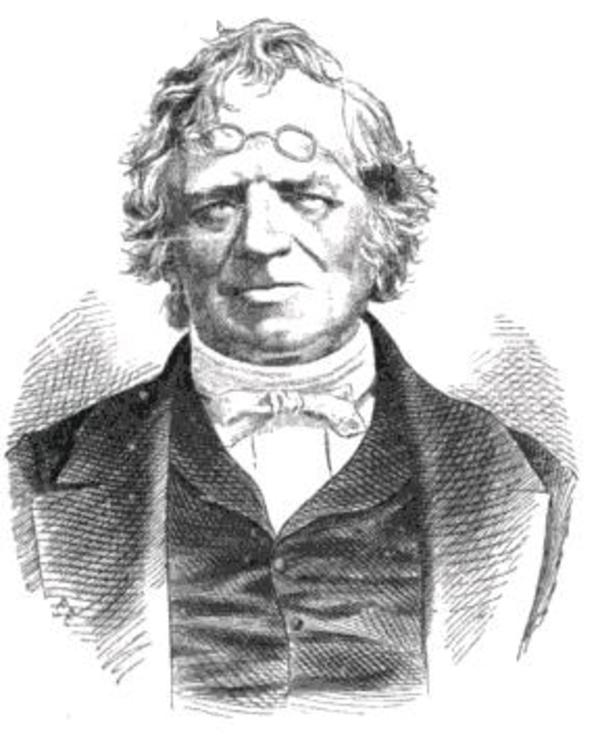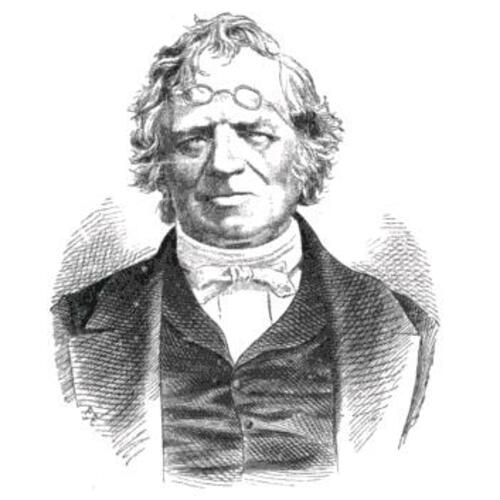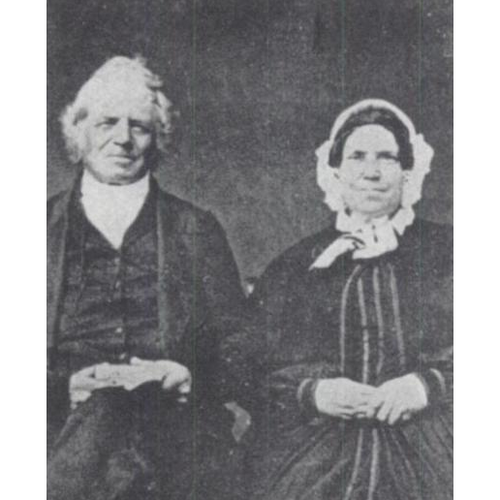
Source: Courtesy of Wikimedia Commons
CASE, WILLIAM, Methodist minister; b. 27 Aug. 1780 in Swansea Township, Mass.; m. first 4 May 1829 Hester Ann Hubbard*, and they had one daughter; m. secondly 28 Aug. 1833 Eliza Barnes, and they had one daughter; d. 19 Oct. 1855 in Alderville, Upper Canada.
William Case was the eldest son of George Case, a farmer of English descent, whose family had immigrated to Massachusetts in the 17th century. Probably the Cases were Baptists and they must have shared the New England concern for literacy. “After years of religious impressions, and a sinful course,” William Case was converted in February 1803. Two years later he was admitted on trial as an itinerant minister by the New York Conference of the Methodist Episcopal Church and appointed to the Bay of Quinte circuit in Upper Canada.
The Methodist Episcopal Church was one of the most aggressively evangelical denominations in the United States. At a very early stage it responded to the pleas of former citizens of the northern states now resident in Upper Canada, and by 1805 the Upper Canada District was well established. For this area, as for the church as a whole, the Methodist bishops recruited young men who had demonstrated a deep commitment to Methodist teaching and the ability to evoke conversion experiences in their followers. Justification by faith was the initial step on the way to Christian perfection, which could be achieved only through a disciplined life. The Methodist system thus depended on the careful selection of many evangelists and a smaller number of those who could administer the itinerancy and foster the quest for holiness in this life.
From the outset, Case must have been identified as a man of promise. Described by Nathan Bangs* as about “five feet, eight inches high, and every way well-proportioned,” he had “a pleasant expression of countenance, while yet there was an air of solemnity about him, that could hardly fail to leave the impression that his mind was chiefly fixed upon the interests of the world to come.” A thoughtful reader and student, Case was also an assiduous and ardent preacher who was determined “to spend all my time, my talents & property, yea my life in the service of God.” Bangs noted that his voice was clear and that he “spoke easily and fluently.” His preaching “was rather practical and experimintal than doctrinal” and he was successful in part because “he was one of the most guileless, friendly and obliging of men.” He thought nothing of travelling 2,500 miles and preaching 360 times in one year. His journal for 1808–10 reveals a diffident, humble personality, homesick for his family, frequently beset with self-doubt about his ability and his vocation, and urged on and comforted by ecstatic spiritual reflections. This combination of qualities and his fondness for singing, in and out of the pulpit, endeared him to his congregations and enhanced his appeal to the sceptical and the disaffected. His preaching skill, loyalty, and careful attention to detail were recognized quickly by his colleagues and his superiors.
Case was ordained deacon in 1807 and elder in 1808. After a year on the Ancaster circuit (1808–9), he was asked to revive the work begun by Bangs in 1804 and to develop a new circuit in the remote lower Thames valley. In 1810 he became presiding elder of the Cayuga District in the newly created Genesee Conference. He never returned to the circuit itinerancy. He remained as a presiding elder in the United States during the war years, 1812–15, returning to Upper Canada in 1815 as presiding elder of the Upper Canada District, which embraced the area from Detroit to Kingston. For the rest of his career, Case lived and worked in the Canadas.
Despite the wartime disruption, Canadian Methodism revived quickly after 1815, but it was beset by conflict between the Methodist Episcopal ministers and Wesleyan missionaries from the British Wesleyan Conference. As an American and a leading figure in the Genesee Conference, Case was labelled vindictively and probably inaccurately as a “republican Methodist.” Elected to the general conference of 1820, he had some part in easing the tension between the two churches. He recognized, however, that the association between the Methodist societies in Upper Canada and the parent body in the United States was changing. At the general conference of 1824 he promoted successfully the formation of a separate conference in Upper Canada. As a presiding elder in the new conference, and its secretary from 1824 to 1827, he helped to contain the attack on the conference by his former friend and colleague, Henry Ryan*, which was engendered in part by continued dissatisfaction with the conference’s American ties. In conformity with decisions taken at the 1824 general conference, the independent Methodist Episcopal Church in Canada was established in 1828 with the consent of the church in the United States. William Case was elected general superintendent pro tempore and superintendent of the conference’s Indian missions. He was also named to a committee with George Ryerson* and James Richardson* created to foster friendly relations with the British Wesleyans.
Doubtless the Canadian Methodists intended to perpetuate the American Methodist version of the episcopacy and expected to confirm their most popular preacher as general superintendent or bishop. The evidence suggests that Case did not have the requisite stature, self-confidence, or ambition. In any event, although he was elected general superintendent pro tempore annually until 1833, by 1828 his overriding concern was to promote the welfare of the Indian missions of which he was the effective founder, and to which he would devote the rest of his life.
In 1820 several thousand Indians were living in Upper Canada, including the majority of the Six Nations on their Grand River lands, a number of Ojibwa groups, and some tribal remnants from the United States. These people had been exposed in varying degrees to the impact of European business, social mores, cultural values, and religion. With few exceptions they had not become assimilated to western culture; rather they had become demoralized and partly disillusioned with their social and religious convictions. They were being pushed back relentlessly along the frontier of settlement, a process symbolized by the land cessions which they made regularly. Probably most white inhabitants assumed that eventually they would retreat into the wilderness or disappear from view altogether.
Fortuitously, one of Case’s first circuits was in the Ancaster area, where he met the Mohawk chief Henry [Tekarihogen*] and some of the Six Nations group. From the outset, unlike many Europeans, he seems to have regarded the natives as human beings who were open to Christian teaching and in grave need of salvation. In 1822, stirred by the support of the general and Genesee conferences, he stressed that “my mind recently has been impressed with the importance of our trying to better their [the Indians’] condition and I have spoken to several of our brethren about the matter.” In June 1823 his determination was strengthened immensely by the conversion, at a camp meeting where he preached, of Peter Jones. “Now,” Case exclaimed, “is the door opened for the work of conversion among his nation!” Peter Jones was received on trial for the itinerancy in 1827 and became the first Indian minister in the Canada Conference. The collaboration between the two men, begun shortly after Jones joined the Methodist community, continued until Case’s death.
Case believed that “the Indian character . . . has been but little understood. . . . Let these people possess the advantages of Christian example and instruction and they are as capable of instruction and good impressions as any nation.” Thus, with the help of Jones, other Indian converts including Peter Jacobs [Pahtahsega*], and some of his ministerial brethren, he began a systematic program of missionary expansion through which all the Indian groups in Upper Canada were exposed to Methodist teaching. Convinced as he was that Christianization and westernization were integral parts of the same process, he and his collaborators sponsored translations of the New Testament and hymns, established schools, and instructed the natives in the rudiments of European agriculture and technology.
Case assumed, moreover, that the Indians should be enabled and encouraged to come together in permanent settlements in which secular and religious instruction could be provided for them. To this end, in 1826 he secured two islands in the Bay of Quinte, on one of which, Grape Island, houses were built, agricultural implements were collected, and the Indian women were instructed in housekeeping and other crafts. Both of the women Case would marry, Hetty Hubbard and Eliza Barnes, taught at the settlement. Case travelled throughout the northern United States to raise money to support the community and to secure additional teachers. Religious services were held regularly and the Indians were urged to attend quarterly and camp meetings. By 1828 there were at least 79 converts, who were learning with Peter Jones’s help to plant gardens and to live in a European style. Case would write optimistically two years later from Grape Island “of the stability and perseverance of most of all who have embraced the Gospel.” One of the original Indian settlers, John Sunday [Shah-wun-dais*], went on to become a Methodist preacher himself.
In 1832 the conference, confronted with the prospect of rivalry with representatives of the British conference, agreed to adopt a proposal from John Ryerson* to unite with the latter, despite Case’s passionate advocacy of independence. The next year the Wesleyan Methodist Church in Canada was created and the Upper Canadian missions came under the control of Wesleyan superintendent Joseph Stinson*. Case was relegated to the role of “General Missionary to the Indian tribes” and charged to “pay attention to the Translation of the Sacred Scriptures into the Indian languages.”
His missionary zeal was not diminished; from his base at the Credit Mission (Mississauga) he continued his visitations of the missions. In 1836 he was again elected secretary of the conference and over the next two years he established a new model settlement at Alderville near Rice Lake, where he lived until his death. In this new planned community each native family had a 50-acre farm, house, and garden, and the men were instructed in carpentry and agriculture. A day-school and a coeducational boarding-school that emphasized domestic skills were established in 1839. Late in 1848 a new three-storey building was opened with 26 students and room for 100. By 1852 the Alderville Industrial School had 43 boarders and 35 day students; arithmetic and rudimentary science were taught and woollen cloth and knitwear were manufactured. The success of this venture had led to the establishment in 1849 of the Mount Elgin Industrial Institution under Samuel Dwight Rice*. Both were sponsored jointly by the British Wesleyan Missionary Society and the provincial government and partly supported by subsidies from the Indians’ annuities. Here the missionaries could act on their belief in “the necessity of an entire separation” of the children “from their friends and relatives and a continued non-intercourse with them until they are made emphatically new creatures.”
Despite his preoccupation with transforming the Indians into “new creatures,” Case did not lose contact with the wider interests of Canadian Methodism. When the union between the Canadian and British conferences was dissolved in 1840 at a special session of the Canada Conference over which he presided, his concern for the Indian missions led him to espouse the cause of the Wesleyans, to whom he believed that God had “committed the conversion of the Indian tribes in British North America.” In the lengthy negotiations that preceded the reunion of the two conferences in 1847 he played a cautious role, largely because he distrusted Egerton Ryerson*, whose guileful advocacy had undermined his own position in 1832. In 1847 Case declared that “before there was any ‘hugging and kissing’ there should be some ‘confession,’” but he joined in the post-reunion rejoicing. In 1852, aged 72, he was given permission to work part time. His last public act was to deliver his jubilee sermon at the 1855 session of the conference on the text “All the paths of the Lord are mercy and truth unto such as keep his covenant and his testimonies.” In this he recalled incidents in his long career as an intinerant and urged his brethren not to be diverted “from the work of God in the growth of grace and the advancement of pure and undefiled religion throughout the land!”
William Case died on 19 Oct. 1855 of injuries sustained in a fall from his horse, and he was buried in Alderville amidst the Indian people whom he loved and served in his own way. His death marked the end of the first phase of Canadian Methodism, which was characterized largely by simple evangelical preaching and an intense determination to bring the Gospel to every settlement in Upper Canada. Case’s style and teaching epitomized the qualities of the Methodism of his time. He took the lead as well in reaching out beyond the European community to the demoralized Indian tribes and bands. His acceptance of the natives as human beings and his concern for their material, moral, and spiritual needs gave them a renewed sense of pride and hope which ultimately may have had some effect on their will to live as autonomous societies. It was fitting that his brethren should testify that for the Indians “he lived and died” and that they could not forget “his works of faith and abundant labours of love for half a century.”
[Many of William Case’s letters were printed in the Christian Guardian, the Methodist Quarterly Rev. (New York), and its predecessors, the Methodist Magazine (1818–28) and the Methodist Magazine and Quarterly Rev. (1830–40); his Jubilee sermon delivered at the request of and before the Wesleyan Canada Conference, assembled at London, C. W., June 6th, 1855 was published in Toronto by the Wesleyan Book Room in 1855. His manuscript diary from April 1808 to August 1809 is in the UCA, as is a microfilm copy of SOAS, Methodist Missionary Soc. Arch., Wesleyan Methodist Missionary Soc., corn, North America, which includes numerous manuscript letters.
The UCA also possesses copies of various official publications of the conferences to which Case belonged in the United States and Canada, including the following annual reports of their missionary societies, which contain much information on his activities: the Methodist Episcopal Church, Canada Conference (1825–29), the Methodist Episcopal Church in Canada (1829–31), and the Wesleyan Methodist Church in Canada, (1833–55), all published in York or Toronto. A complete collection of the minutes of the Wesleyan Methodist Church in Canada and its predecessors from 1824 is available in The minutes of the annual conferences . . . from 1824 to 1845 . . . , a one-volume compilation published in Toronto in 1846, and in the Minutes [of the annual conference] (Toronto), 1846–55.
The individual conference and district minutes of the Methodist Episcopal Church to which Case belonged prior to the formation of the Canada Conference in 1824 are not at the UCA, but his career from 1805 to 1823 can be traced in the collected Minutes of the Methodist conferences, annually held in America; from 1773 to 1813, inclusive (New York, 1813), and in the annual compilations of Minutes taken at the several annual conferences (New York) for 1820, 1822–23. The minutes for 1814–19 and 1821 are not available.
The principal biography of Case is Carroll, Case and his cotemporaries, which includes many of his letters. Case also figures largely in G. F. Playter, The history of Methodism in Canada: with an account of the rise and progress of the work of God among the Canadian Indian tribes, and occasional notices of the civil affairs of the province (Toronto, 1862), and appears frequently in Peter Jones, Life and journals of Kah-ke-wa-quo-nā-by (Rev. Peter Jones), Wesleyan missionary, [ed. Elizabeth Field and Enoch Wood] (Toronto, 1860), and French, Parsons & politics. g.s.f.]
Cite This Article
G. S. French, “CASE, WILLIAM,” in Dictionary of Canadian Biography, vol. 8, University of Toronto/Université Laval, 2003–, accessed January 22, 2025, https://www.biographi.ca/en/bio/case_william_8E.html.
The citation above shows the format for footnotes and endnotes according to the Chicago manual of style (16th edition). Information to be used in other citation formats:
| Permalink: | https://www.biographi.ca/en/bio/case_william_8E.html |
| Author of Article: | G. S. French |
| Title of Article: | CASE, WILLIAM |
| Publication Name: | Dictionary of Canadian Biography, vol. 8 |
| Publisher: | University of Toronto/Université Laval |
| Year of revision: | 1985 |
| Access Date: | January 22, 2025 |




